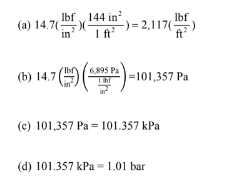Atmospheric pressure is the weight of the column of air over an area. For example, under standard conditions, the atmospheric pressure is 14.7 lbf/in.2 . This value means that the column of air in the atmosphere above a surface with an area of 1 in.2 will exert a force of 14.7 lbf. Convert the atmospheric pressure in the given units to the requested units: (a) 14.7 lbf/in.2 to lbf/ft2 , (b) 14.7 lbf/in.2 to Pa, (c) 14.7 lbf/in.2 to kPa, and (d) 14.7 lbf/in.2 to bars. Show all of the conversion steps. [Note: One Pascal (1 Pa) is equal to one newton per meter squared (1 Pa = 1 N/m2 ) and 1 bar = 100 kPa.]
What will be an ideal response?

Environmental & Atmospheric Sciences
You might also like to view...
A species' niche within a community describes
A. the species it competes with in the community. B. its position in a food chain or food web. C. the total set of biotic and abiotic resources it uses within the community. D. how it evolved in response to interspecific competition.
Environmental & Atmospheric Sciences
What are the two major types of weathering?
A. Abrasion and solution. B. Chemical and biochemical. C. Physical and abrasive. D. Mehcanical and physical
Environmental & Atmospheric Sciences
How does mafic magma originate from ultramafic rock at a spreading ridge? What will be an ideal response?
Environmental & Atmospheric Sciences
Which of these terms represents a layer of the atmosphere defined by function rather than temperature?
a. thermosphere b. troposphere c. ionosphere d. stratosphere e. mesosphere
Environmental & Atmospheric Sciences